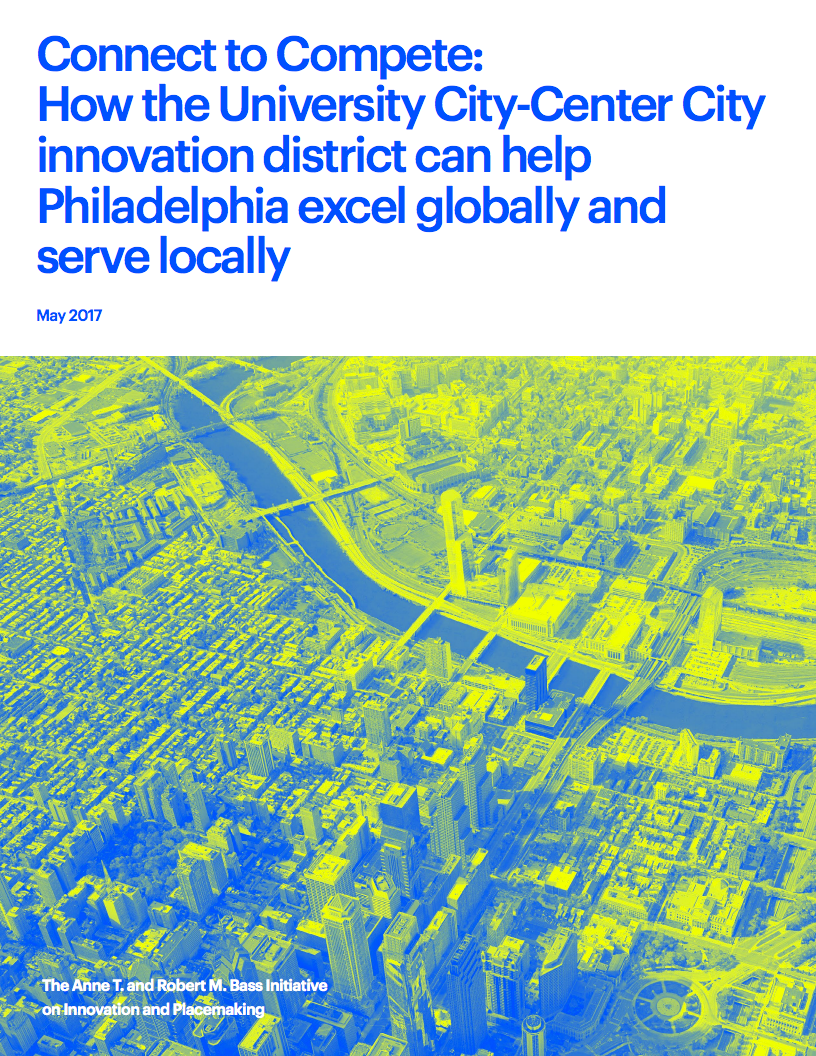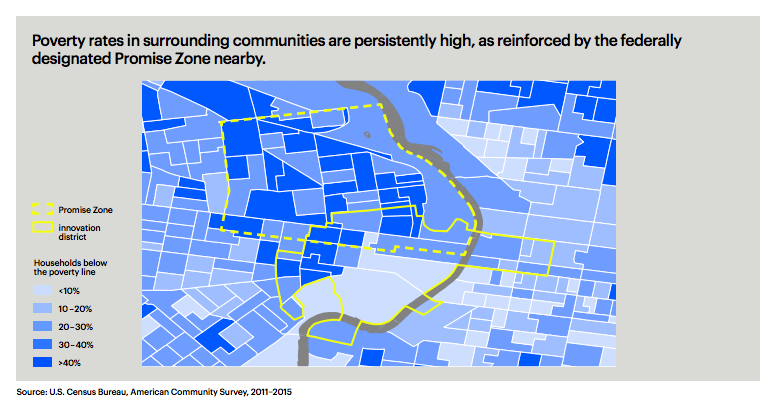Brookings report calls for more local investment to unleash ‘innovation district’ potential

Before a room packed with Philadelphia’s business elites Thursday morning, Brookings Institution researchers described the city as standing on the precipice of greatness. All it will take is a little leap of faith among the region’s moneyed class and the city will take off in an economic ascendency, carried on angel investor wings to a heavenly future of fulsome, equitable growth.
Brookings was hired by a consortium of the region’s biggest businesses and institutions—Comcast, Drexel University, the Children’s Hospital of Philadelphia, FMC, Independence Blue Cross, PECO, the University City Science Center, Vanguard, the University of Pennsylvania and it’s health system—to study how Philadelphia could turn University City and west Center City into an “innovation district—a dense, dynamic engine of economic activity where research-oriented anchor institutions, high-growth firms, and tech and creative startups are embedded within a growing, amenity-rich residential and commercial environment.”
The report comes a year after Drexel and Brandywine Realty Trust unveiled plans for Schuylkill Yards, a $3.5 billion real estate development clustered between Drexel’s campus and 30th Street Station, intended to serve as the heart of the city’s innovation district.

The report’s main author, Bruce Katz, made a name for himself arguing that cities’ economic futures lie in developing their competitive advantages. Today that means fully capitalizing on Philadelphia’s clustering of human capital, particularly in life sciences—the colloquial “eds and meds” sector. To fully leverage that kind of competitive advantage, cities should concentrate lead industries into innovation districts. When research-and-development focused institutions and businesses all converge in close proximity, they tend to create an agglomeration effect where the benefits (easier ability to attract talent; close access to potential customers, vendors, and collaborators) outweigh the costs (competition among neighbors for the aforementioned talent and higher rents).
So what’s standing in Philadelphia’s way to the innovation promised land? Philadelphians, mainly, who tend to invest outside the region instead of supporting new businesses.
One could read the report partly as an intricate marketing brochure for Schuylkill Yards, a 58-page investment prospectus with the imprimatur of a prestigious think tank, aimed at convincing the region’s deep pockets to underwrite this local opportunity. Indeed, when asked what needs to happen to make the innovation district takeoff, Katz pointed to the area’s lack of local investment. “There is a lot of capital sitting on the sideline, a lot of wealth sitting on the sideline in the city of Philadelphia and the metropolitan area,” said Katz. “We need to attract that capital to investment in the innovative and inclusive growth of not just this district, but the entire city.”
The report lays out three broad flavors of challenges in the city’s way: innovation, inclusion, and place. On the last, the development of Schuylkill Yards would be the critical component says the report, along with University City District’s ongoing placemaking efforts, a recommended task force to guide public-realm investments along key corridors like Market Street, and Amtrak’s long-term goal of capping 30th Street Station’s railyard.
On inclusion, the report had little more to offer from last year’s Schuylkill Yards announcement, when Drexel president John Fry said the development would “benefit thousands of low-income families [in nearby communities] without disrupting the fabric of their neighborhoods.”
“Our major recommendation is ramping up the West Philly Skills Initiative,” said Katz. The program run by University City District tailors job—training programs around the positions local businesses need to fill and graduates about 120 community residents a year. Katz said the program should increase its size three or five fold. Even if capacity increased fivefold, it would still leave many out: last year, WPSI saw 2,058 applicants. In March, Pew Charitable Trusts bestowed a $600,000 grant on the program.
The report notes that 55 percent of the jobs located currently in the proposed innovation district require less than a four-year degree. Targeted job training is all many neighbors would need to join in the economic bounty imagined in the near future. The report also called for more coordinated support among the anchor institutions for local schools, noting that Penn, Drexel and the Science Center all have their own local neighborhood partnership programs operating independently from one another.
Brookings report also recommended an expansion of ongoing efforts by the city and Drexel to spend procurement dollars locally, rather than hiring vendors from outside the city or region. All told, ensuring inclusivity in the growth would cost between $10 and $25 million at the start, said Katz. “It’s not an impossible task. We’re not talking about billions.”
The report is silent on affordable housing.
“Gentrification is not Philadelphia’s problem,” said Katz. “You don’t have a housing problem, you have an employment problem and a skills problem.” Affordable housing is plentiful in the city, but good jobs are scarce. As Inga Saffron wrote recently, one of the larger problems in rapidly gentrifying neighborhoods is ensuring residents on fixed incomes can stay in their homes despite appreciating real estate taxes (or sell and cash out on the newfound equity, if they so choose). In nearby West Powelton and Mantua, current concerns focus more on an influx of new apartments aimed at Drexel students than affordability.
Finally, for the district to achieve the concentration of innovative firms to launch a virtuous economic cycle, the Brookings report recommends an Innovation Council, “a consortium of corporate, academic and philanthropic leaders that meet to decide—not to discuss,” said Katz. “They meet to get stuff done.” This proposed Council—perhaps composed of many of the same institutions that funded the study—would then oversee strategies for inclusion, attracting local investment, and encouraging more local entrepreneurship called for in the report.

WHYY is your source for fact-based, in-depth journalism and information. As a nonprofit organization, we rely on financial support from readers like you. Please give today.





